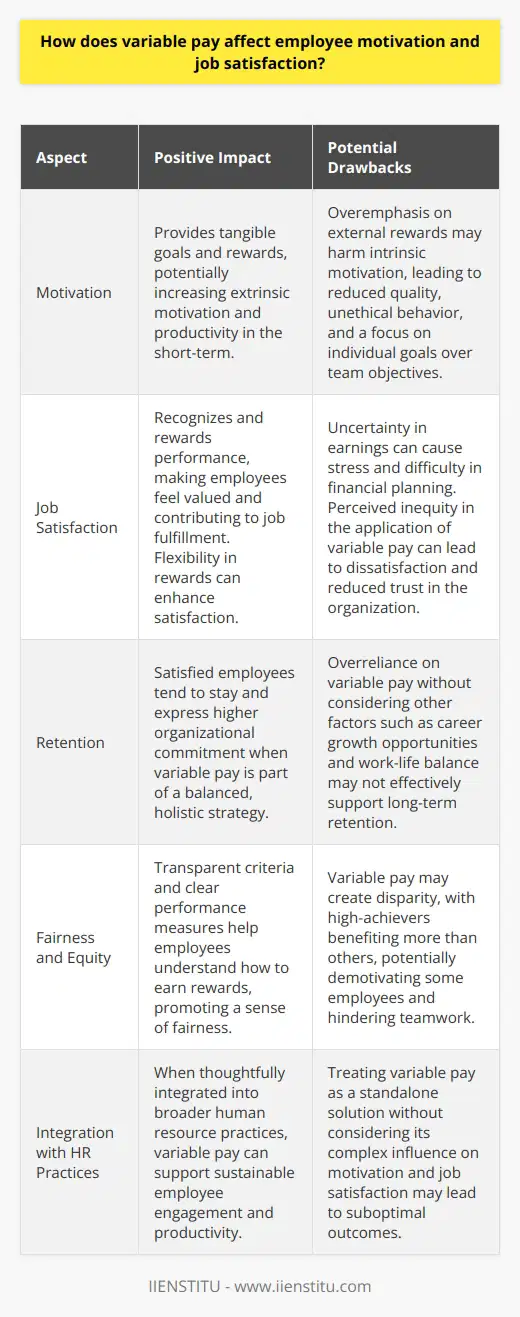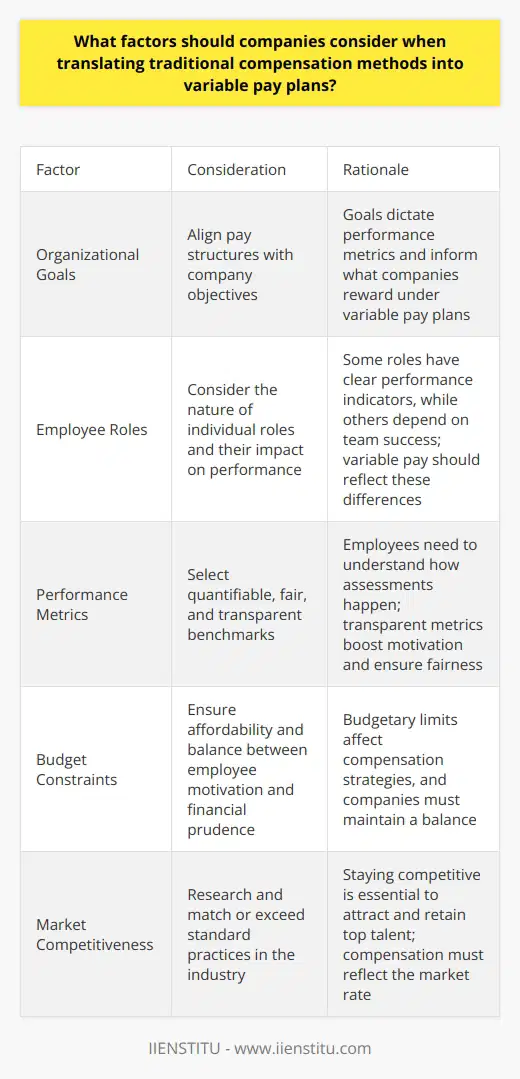
In the realm of modern compensation, the concept of variable pay has steadily gained traction among forward-thinking organizations striving to incentivize performance and align employee interests with the company's financial success. This intricate linkage between compensation and performance not only motivates employees but also serves as a strategic tool for organizations to drive their business objectives.
Understanding the essence of variable pay is paramount for both managers designing compensation structures and for employees navigating their career paths. In this article, we delve into a comprehensive analysis of variable pay, examining its fundamentals, noting the variegated forms it can take, and evaluating its implications.
We also explore the challenges and best practices in implementing variable pay programs, illuminated by examples that have set benchmarks in the industry.
Understanding the Basics of Variable Pay
The Concept of Variable Pay
Variable pay fundamentally rethinks the traditional compensation model by introducing a dynamic element where a portion of an employee's total earnings is tied to certain pre-defined criteria or metrics. This compensation strategy goes beyond the security of a fixed salary to offer a potential for high rewards based on exceptional performance.
Unlike fixed pay, which is predictable and steady, variable pay brings a level of variability to an individual's income, making it partly contingent on achieving specific goals or benchmarks.
The essence of this model lies in its direct correlation with performance, making it an ally of meritocracy within the workplace. Those who outperform expectations stand to receive a remunerable acknowledgment of their efforts, which goes beyond mere recognition.
Consequentially, this form of recompense serves as a tangible motivator for employees to harness their potential, augment their skills, and align with the organization's strategic roadmap.
Workforce Segmentation: A Strategic Approach for Business Success
Workplace Harassment: Effects, Legal Issues and Prevention Strategies
360-Degree Feedback: An In-depth Analysis of Its Implications & Impact
The differentiation of variable pay from fixed pay lies in the former’s ability to serve multiple strategic ends—from driving individual performance to fostering organizational agility by maintaining payroll flexibility.
Types of Variable Pay
The typology of variable pay spans various forms, each tailored to specific organizational objectives and employee roles. Bonuses are perhaps the most widely recognized type of variable pay, often granted as annual sums awarded for meeting or exceeding individual or company-wide targets. Commissions, on the other hand, are closely linked to sales roles, where payouts are proportionate to the volume of business generated by the employee.
Profit-sharing schemes are another manifestation of variable pay, one that directly aligns employees' remuneration with the financial health of the organization. Under such an approach, employees receive a share of the profits, which instills a strong sense of ownership and can drive collective performance.
Incentive pay, which can take the shape of stock options, deferred compensation, or project-based bonuses, is a more nuanced form of variable pay designed to reward specific achievements and often to retain high-value talent.
Connecting Variable Pay to Employee Performance Metrics
Developing a robust connection between variable pay and employee performance necessitates the employment of clear, equitable key performance indicators (KPIs). The selection and deployment of KPIs are critical, as they should reflect not only the attainable targets but also endorse behaviors that align with the company's culture and long-term vision.
The closely knitted relationship between productivity and variable pay underscores the symbiotic nature of this compensation system. When employees recognize the transparent and direct link between their performance and their remuneration, it can lead to a natural boost in the quality and quantity of their output.
Moreover, the integration of effective performance metrics with variable pay programs can optimally drive organizational and individual growth, creating a win-win architecture for all stakeholders involved.
The Advantages and Disadvantages of Variable Pay
Advantages of Variable Pay
One of the cardinal advantages of variable pay lies in its potential to motivate employee performance. When the prospect of earning more is directly tied to output or quality of work, employees are more likely to push their boundaries and strive for excellence. This intrinsic motivation can lead to substantial productivity gains and consequently a thriving business.
Financial benefits for high performers are an explicit advantage of a well-structured variable pay system, offering a merit-based pathway to greater earnings. This not only provides a platform for recognition but also aids in talent retention by financially rewarding those employees who consistently deliver exceptional work.
From an organizational standpoint, variable pay is a cost-effective compensation strategy. It allows companies to adjust their payroll expenses in alignment with their financial performance. During periods of economic downturn, variable pay can reduce the strain on the company's finances without necessitating widespread layoffs or salary cuts. Conversely, in times of prosperity, it can be an effective means of sharing the windfall with the workforce.
Disadvantages of Variable Pay
Despite its benefits, variable pay is not without potential pitfalls. A salient concern is the possibility of creating inequality within the workforce. Overemphasis on individual performance can create disparities among employees, potentially leading to a divisive culture and a workplace where collaboration is hindered rather than fostered.
In a similar vein, an ill-conceived variable pay structure can jeopardize team cohesion. If the variable pay is perceived as favoring certain roles, departments, or individuals, this can lead to resentment and erosion of the collective team spirit. The competitive pressure to earn more can override the sense of unity and collective purpose necessary for organizational success.
Moreover, the inherent uncertainty of earnings associated with variable pay can be a source of stress for employees. Dependence on variable pay to meet personal financial obligations can be unnerving, particularly when the ability to affect outcomes is limited or the performance metrics are deemed unfair or outside one's control.
Implementation and Management of Variable Pay Programs
Key Factors to Consider in Implementing a Variable Pay Program
Instituting a variable pay program is a complex process that requires careful consideration of the organization's financial status. A thorough analysis must ensure the sustainability of the program without compromising the company's financial resilience. Additionally, the appropriateness of the model must be assessed in light of the organization's goals and culture.
It is also imperative to maintain fairness in the chosen performance metrics. The criteria that govern variable pay must be equitable, unambiguous, and achievable. Fair and attainable metrics strengthen employees' trust in the compensation system and ensure that the variable pay program is received positively.
Best Practices for Managing Variable Pay
For effective management of variable pay, transparency in performance evaluation is fundamental. Employees should have clear visibility on how their performance is assessed and how it connects to their compensation. This transparency helps build trust and ensures that the employees feel fairly treated.
Regular communication with employees is also critical in managing expectations and providing them with an understanding of how the company's performance could impact their variable pay. This ongoing dialogue fosters alignment and can mitigate uncertainties that revolve around variable compensation.
Moreover, periodic review of variable pay programs is essential to adapt to organizational changes, economic fluctuations, and workforce dynamics. Regular assessments and adjustments ensure that the programs remain valid, fair, and effective in fulfilling their intended objectives.
Noteworthy Examples of Variable Pay Programs
Examples of Successful Variable Pay Programs
There are various companies that serve as paragons for successful variable pay programs. These firms have harnessed the power of customized incentive structures to not only propel their employees to new heights of performance but also to anchor themselves more firmly in their respective markets. The particulars of these cases usually highlight meticulous planning, relentless communication, and relentless pursuit of fairness.
Lessons Learnt from the Examples
Analyzing these examples reveals several lessons. Key among them is the need for a consistently communicated vision that connects employee efforts to the broader organizational goals. These success stories also reveal that the most effective variable pay programs are those that are tailored to the specific dynamics of the business and the composition of its workforce.
Conclusion
Recap of Major Points
Variable pay is an innovative compensation strategy designed to reward employees for exceptional performance. Its many forms, from bonuses to profit-sharing, offer versatile tools for organizations to incentivize their teams. However, it also carries certain risks, such as the potential to undermine equity and cohesion within the workforce.
Final Thoughts on Variable Pay
When adequately implemented and managed, variable pay programs can significantly contribute to the organization's success. They can provide a highly motivational compensation framework that aligns individual ambitions with company goals, fostering a culture of high performance and shared success. As we continue to navigate an ever-evolving labor market, variable pay remains a salient strategy that can redefine employer-employee relationships for mutual benefit.
Frequently Asked Questions
What is variable pay and how does it serve as a modern compensation strategy in today’s workforce?
Understanding Variable Pay
Variable pay stands out in modern compensation strategies. It differs from fixed salaries. Employees earn it based on performance measures. This can include sales commissions, bonuses, and profit-sharing.
Goals of Variable Pay
Alignment of interests forms a core goal. It aligns employee performance with company success. Motivation often increases—a direct effect of potential financial rewards.
Variable Pay Implementation
Incentives drive the model's success. To implement it effectively, clear criteria are necessary. Employees must understand the goals. Equally important are the methods of evaluation.
Types of Variable Pay
Several types exist. Examples include:
- Commissions: Sales-focused reward system.
- Bonuses: Achievement of specific targets triggers payment.
- Profit-sharing: Distributes profits among employees.
- Stock options: Offers shares as a performance incentive.
Advantages of Variable Pay
It boosts performance. It also fosters a more engaged workforce. Costs link directly to business outcomes. Hence, it provides a flexible payroll cost.
Risks and Considerations
It carries risks. Transparent communication is essential. Employees need to trust the system's fairness. Misunderstanding may lead to dissatisfaction.
Variable Pay as a Retention Tool
It can serve as a powerful retention tool. Employees see the potential for personal growth. They feel their contributions matter.
Conclusion
Variable pay shapes modern workforce dynamics. It enables businesses to adapt. It rewards high performers. It aligns with today's drive for results-oriented labor practices.

How does variable pay affect employee motivation and job satisfaction?
The Impact of Variable Pay on Employee Motivation
Variable pay ties compensation to performance. It rewards achievement. Typically, this includes bonuses and incentives. Organizations use it widely.
Understanding Variable Pay
Variable pay can take many forms. Examples are bonuses, commissions, and profit-sharing. Each aligns with distinct goals. This alignment supports organizational objectives.
Motivation and Variable Pay
Intrinsic motivation stems from personal fulfillment. Extrinsic motivation derives from external rewards. Variable pay impacts extrinsically. It provides tangible goals. Employees often work harder.
Financial incentives can indeed boost motivation. Employees feel the direct impact of their efforts on earnings. As a result, productivity may rise.
Short-term benefits are evident. Employees push for immediate gains. Yet, long-term effects bring concern. Overemphasis on rewards may hurt intrinsic motivation.
Quality can suffer. Some may sacrifice it for speed. Others may engage in unethical behavior. The pursuit of bonuses can lead to such risks.
Perceptions of fairness influence motivation. Variable pay may create disparity. High-achievers benefit more. This can demotivate others.
Teamwork can wane. Competition may displace collaboration. Team goals become secondary. Individual goals take precedence.
The Role of Job Satisfaction
Job satisfaction pertains to employee contentment. It reflects attitudes towards the job. Multiple factors contribute to it.
Variable Pay's Role in Job Satisfaction
Variable pay can positively affect satisfaction. It recognizes and rewards performance. Employees feel valued. This recognition contributes to job fulfillment.
Flexibility in rewards can improve satisfaction. Employees appreciate control over compensation components. Customization enhances the value perception.
Yet, variable pay can also have drawbacks. Uncertainty accompanies fluctuating earnings. This can cause stress. Financial planning becomes difficult.
Consistency in applying variable pay is crucial. Employees scrutinize fairness. Any perceived inequity creates dissatisfaction. It may reduce trust in the organization.
Long-term satisfaction depends on holistic strategies. Variable pay forms just one element. Career growth opportunities also matter. Work-life balance is equally important.
Job satisfaction correlates with retention. Satisfied employees tend to stay. They express higher organizational commitment. Thus, retention strategies should balance variable pay with other elements.
Variable Pay: A Balanced Approach
A balanced approach to variable pay is necessary. It must align with overall compensation strategy. Thus, it should complement base salary smartly.
Organizations need transparent criteria. Performance measures should be clear. Employees then understand how to earn rewards.
Variable pay requires careful management. It should not undermine intrinsic motivation. Nor should it compromise collaboration.
Equity remains key in variable pay structures. It requires constant monitoring. Feedback loops are necessary. They ensure continuous improvement.
Organizations should remember: variable pay is not a panacea. It influences motivation and job satisfaction complexly. Thus, they must integrate it thoughtfully into broader human resource practices. This integration supports sustainable employee engagement and productivity.

What factors should companies consider when translating traditional compensation methods into variable pay plans?
Understanding Variable Pay Plans
Variable pay plans align compensation with performance. They differ markedly from fixed salary models. Traditional pay assures stable incomes. Variable pay adds fluctuation, depending on achievements. This change requires thorough consideration.
Assess the Organization's Goals
Every company has unique objectives. Aligning pay structures with these is crucial. Goals dictate performance metrics under variable plans. They inform what companies reward.
Evaluate Employee Roles
Individual impact varies across roles. Consider the job's nature. Some roles have clear performance indicators. Others depend on team success. Variable pay ought to reflect these differences.
Determine Performance Metrics
Performance metrics serve as benchmarks. They must be quantifiable, fair, and transparent. Employees need to understand how assessments happen. Transparent metrics boost motivation. Selecting the right benchmarks ensures fairness.
Understand Budget Constraints
Budgetary limits affect compensation strategies. Companies must ensure affordability. They should balance between motivating employees and financial prudence.
Analyze Market Competitiveness
Staying competitive is essential. Compensation must reflect the market rate. Research standard practices in your industry. Aim to match or exceed these benchmarks. This attracts and retains top talent.
Communicate Clearly
Communication is key. Employees need to understand changes. Companies should explain the rationale and methods. This includes detailing how the company calculates variable pay.
Incentivize Desired Behaviors
Variable pay plans reward certain behaviors. Companies should underline desired actions. These should link back to organizational goals. It's imperative that employees see this connection.
Ensure Legal Compliance
Regulations govern compensation practices. Companies must adhere to them. Consider both national and local laws. Ensure the variable pay plan is legal.
Factor in Scalability
Scalable plans offer long-term utility. As the company grows, so can the plan. It must adapt to changing conditions. Therefore, flexibility is important.
Provide Support Systems
Support helps staff adapt. Training sessions might be necessary. These can help employees transition to new models. Regular updates and feedback are also important.
Promote Fairness and Equity
Equity encourages a positive work environment. Unequal pay can cause discord. Ensure fairness among different employees and departments. This improves morale.
Adapt and Evolve
Business needs change with time. Thus, variable pay plans must evolve. Regular evaluations help maintain relevancy. Adjusting plans ensures ongoing alignment with company goals.
In conclusion, companies must deliberate carefully. Transitioning to variable pay needs strategic thought. It's about more than just compensation. It's about driving performance and achieving goals.



